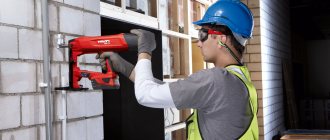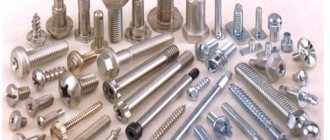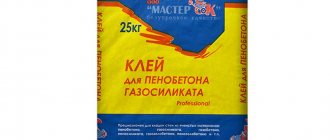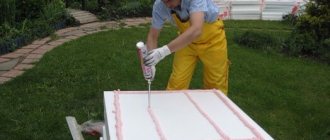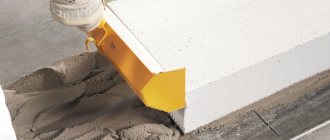Installing anything with this equipment is much faster than with a hammer drill
If you are a professional installer of, for example, drywall, and have become acutely aware that you want to increase your momentum, do more and better, then it’s time to think about updating your tool fleet. Today we will discuss a concrete mounting gun - its types, advantages and disadvantages, and also consider the most popular models on the market. Let's go!
What are mounting guns used for?
destructive force
Concrete mounting guns are a faithful assistant to a professional builder with a wide range of capabilities. They are designed for driving dowels, and can even work on metal, brick, cinder block, etc.
- If you have not seen how this equipment works, you will not be able to imagine how much such equipment speeds up the installation process.
- When working with a conventional hammer drill, to create an attachment point, you perform the following actions: for example, attach a profile to the wall, drill it together with it, place the hammer drill, take a dowel screw and insert it into the resulting hole, hammer it. Agree, long enough.
- In the case of a mounting gun, you only need to accurately set the profile and pull the trigger - this takes a matter of seconds. And just imagine how the installation process speeds up when it comes to large volumes of work.
Gas mounting guns for concrete and metal
- Imagine that you are drilling concrete with a hammer drill and come across steel reinforcement - you will have to make a new attachment point, and the mounting gun has such a driving force that special dowels can pierce even metal beams.
Clip of special dowels
Choosing a gas gun for concrete and other hard surfaces
A gas-type “concrete” gun is designed for instantly driving steel dowels, clips, nails and threaded rods into walls and other surfaces made of masonry building materials, most often into surfaces made of concrete and reinforced concrete.
These devices are characterized by a high “firing” speed and the ability to accurately adjust the force of the shot. The last factor completely eliminates damage to mounted parts, which often happens when using powder analogues.
In this regard, the use of gas mounting guns is recommended and economically feasible in cases where it is necessary to quickly install thin parts (electrical boxes, brackets, mounting rails and strips, steel tires, etc.).
Types of pistols
There are many types of mounting guns, but only three types are used for working with reinforced concrete.
Pneumatics
Air gun for concrete
An air gun for concrete is the most common type among builders.
This type of tool has the following features:
- The simple design ensures long service life and trouble-free operation.
- Very high speed of driving dowels.
- The equipment is quite compact (comparable to a hammer drill) and does not have much weight.
- An air gun for concrete does not require consumables, which makes the price of a shot the lowest among its analogues.
- Working with the tool is extremely simple - not difficult to learn.
- It is possible to operate in places where there is a high probability of explosion.
- The equipment makes little noise and produces virtually no recoil.
- Reasonable price for the kit.
Compressor unit
Of course, this type of equipment also has its disadvantages:
- The main one is the need for a compressor that will create the pressure necessary for the gun to operate. That is, the mobility of an air gun is limited by the length of the hoses with which it is connected to the compressor, which means that it is, in fact, a stationary tool.
- The same hoses create a lot of interference, which makes it inconvenient to work with the gun under the ceiling.
- In addition, the compressor must be connected to the electrical network.
Gas pistols
Professional gas gun for concrete
This type of equipment was specially designed for quick and mobile installation of electrical cables. It is successfully used for working with concrete, metal and wood.
- The main advantage of a gas pistol is its high power and mobility. They can easily carry out installation even at heights.
- Very easy to use.
- The gun is quite heavy, but due to its ergonomic shape it fits perfectly in the hand, working with it is convenient and pleasant, and when you feel this power in your hand...
- Possibility of adjusting the force of the shot.
- This type of equipment does not require a permit, which is beneficial for professional construction companies.
- You can maintain this nail gun for concrete with your own hands.
Its disadvantages are the following:
- The need to use gas cartridges.
- During operation, exhaust gases are generated, which means the room needs to be ventilated.
- The combustion chamber requires constant cleaning.
- The price of the equipment is very high.
Powder type pistols
Powder gun for driving dowels into concrete
Attention! In order to use a powder pistol, you must obtain a permit.
This type of pistol was most common during the Soviet era. Surely many people have found cartridges like this at construction sites.
Cartridges for pistols for concrete
The pistol operates on the principle of a small arms weapon - the necessary energy for hammering a dowel is generated when a blank cartridge is fired.
- Older models of such pistols could be used as weapons, which is why accidents often occurred on construction sites. Today the design has been improved, and the pistols have safety locks - the shot will only occur when the barrel is pressed tightly to the place where the nail is driven in.
- All cartridges for such pistols have the same caliber, but the length of the cartridge case differs, and therefore the charge power.
- The pistols are equipped with a magazine that can accommodate dowels up to 80 millimeters in length.
Some of the useful advantages of such equipment include:
- Very high driving impulse, which makes it easy to pierce concrete and metal;
- The gun is lightweight, which greatly facilitates the work process;
- Possibility of using different types of nails.
There are few disadvantages, and we have already mentioned one of them - the need for permission. The second concerns the prices of ammunition.
Comparing everything that we have written, it becomes obvious that the leader among such equipment will be a gas nailing gun for concrete, since it has the fewest restrictions on use in certain situations.
Construction pistol Toua GSN65
mounting gun Toua GSN65
Gas mounting gun Toua is designed for working on concrete, metal and brick surfaces. When installing plasterboard, suspended ceilings, waterproofing membranes, and plywood, nails from 15 to 65 mm are used. The magazine capacity is 40 nails; the gas cylinder fires 1000 shots per charge.
The weight is one kilogram more than the previous model, but the dimensions are more modest - 380 x 375 x 122 mm, compared to 431 x 134 x 192 mm. They say that the larger the tool, the easier it is to work with it, but it all depends on the base material and the complexity of installation.
Equipment
The delivery includes a nail gun for concrete, 2 batteries, charging, adapter 220V AC-6V DC, instruction manual, packaging.
Performance
The GSN65 product differs from the Toua GSN40A model in its high power, 120 J versus 90, and an increased nail magazine, 20-40. It is possible to use nails with a larger diameter - 2.5 - 3.7. A hammered nail can withstand a load of up to 80 kg, the shot is fired strictly at an angle of 90 degrees to the surface.
The toua gas mounting gun is not connected to the electrical network, unlike a rotary hammer, which means the productivity of work on the construction site increases. The spout of the device is separately adjustable, which allows you to penetrate deeper into the material.
The battery is removable; if necessary, it can be replaced with a spare one without stopping the work process. The power of the device is adjusted automatically, there is a light indicator for charging the battery.
The cost of such a unit is 35-40,000 rubles. For a price of about 30,000 rubles you can buy a Makita gn900 gas nailing gun, it is narrowly targeted, designed for working only on wood, respectively, the length of the nails is 50-90 mm, and the shot energy is 85 J
Video:
Review of the most popular gas models
These are the models of gas guns most often used by installers today.
Hilti GX 120
Pictured is a Hilti concrete gun
This monster from a world-famous manufacturer is designed to work with concrete, reinforced concrete, stone, sand-lime brick, and steel. The body of the pistol is quite large - its weight is 4 kilograms. At the same time, it is perfectly balanced and fits comfortably in the hand.
- There is an LED indicator on the body that indicates the need to replace the gas cylinder.
- The gun has a very reliable gas injection system, which allows it to work non-stop for several hours in a row.
- The stylish body is immediately noticeable, and its shape allows you to drive nails even in hard-to-reach places.
- The pistol magazine holds 40 dowels. One gas cylinder is enough for 750 shots.
The instructions allow you to work with such thick metal
- The unit is supplied in a shock-resistant plastic case, in which, in addition to the gun, you can place replaceable gas cartridges and clips with dowels.
- The kit also includes a mounting foot and a device for removing nails from the head of the X-120 gun, earplugs, safety glasses, a proprietary napkin for caring for the tool, and instructions.
Attention! Consumables (dowels and cylinders) are purchased separately.
- The branded suitcase is painted, like the instrument, in bright red, which makes it recognizable.
This gun is perhaps the most popular among craftsmen and the reason for this is: high productivity and speed of installation, reliable fixation, dust-free operation. The only disadvantage we can note is the loud sound of a shot, so it is recommended to use headphones when working.
Spit Pulsa 700 and 800
Executive class mounting gun
These models of gas pistols are among the most expensive - their cost is about 70,000 rubles. Why is the manufacturer asking for this kind of money?
- Spit Pulsa guns can work on any surface.
- The stroke length at the piston head can be adjusted mechanically, which allows you to set the depth of driving the dowels.
- The force of the shot is adjusted automatically, depending on the surface into which the nail is driven.
- In terms of reliability, these guns can be equated almost to industrial equipment, since they can work non-stop for a very long time. The equipment is indestructible!
- And immediately an unpleasant moment for the user - consumables (gas) are only branded, which means that the cost of one shot will be high, but Chinese nails can also be used.
- The shot speed is the same as that of the Hilti GX-120 - 3 per second. If we compare these units, then, despite the greater variety of materials that Pulsa can work with, the first option is often preferred.
Toua GSN65
A good tool from a Chinese manufacturer
The purpose of the gun is installation on concrete, brick and metal surfaces.
- The magazine capacity is also 40 dowels, while the gas cylinder is enough for 1000 shots.
- The weight including the battery is almost 5 kilograms, despite the fact that the body has smaller dimensions.
- It doesn't fit as comfortably in the hand as Hilti, but that's just a matter of habit.
- The product kit includes: 2 rechargeable batteries, charger, instruction manual.
- The pistol has a high shot power (120J). Together with it, you can use dowels of different diameters - 2.5-3.7 millimeters.
- It is also possible to automatically adjust the force of the shot.
- It has a very reasonable price, around 35,000 rubles.
Aiken MGN 850C Gas
The most inexpensive pistol in today's review
Our hit parade is completed by a budget mounting gun from China, which costs 25,000 rubles.
What can you tell us about this model:
- The shot energy is 85J, which is comparable to equipment designed for working with wood from famous brands, but it is also enough for working with concrete.
- The weight of the pistol is 3.5 kg, the magazine capacity is standard, the number of shots from one cylinder is 1000 times.
- An inexpensive instrument usually comes with accessories, and Aiken is no exception. It comes with: 2 batteries, a charger, earplugs on strings, a 4mm hexagon, a tube of clear lubricant, a gas cylinder fitting and a spare cap for the head.
- The pistol body is assembled flawlessly - good plastic and thick rubber are used. The handle is comfortable and reliable, as are the adjustment locks. It looks good, and most importantly, the price is reasonable.
- A shot from such a pistol will cost you an average of 2 rubles, while the same Hilti costs about 15.
In general, the option for installation work is very worthy, despite the fact that service centers are quite common throughout our country. It cannot be compared with Hilti (in terms of reliability and impact power), but it is a very worthy option and is suitable as a first serious instrument.
What is the Hilti GX 120 assembly unit?
Hilti gas mounting gun
Pneumatic mounting gun for concrete, silicate brick, steel, metal products, brick plaster. It has a durable body, despite its high technical parameters, it weighs about 4 kg, is easy to control and perfectly balanced.
The LED charge indicator pre-notifies you when the gas is running out, which helps prevent unexpected battery shutdowns. The gas injection system is reliable and meets all the owner’s wishes. There is a universal system for operating the unit over a wide temperature range. The body of the product is stylish, attractive, functional, and thanks to its streamlined design, it is easy to secure elements even in the most difficult to reach corners.
The store has:
- 40 fasteners;
- 750 fastenings from one gas cylinder.
This is decent performance in a range of concrete mounting guns.
Tool packaging
The device is supplied in a plastic impact-resistant suitcase; in addition to the main unit, it contains consumables, gas cartridges and nails. The red color of the gun body clearly distinguishes it from other similar products, which makes the hilti gas mounting gun more recognizable and popular in the market of mounting devices. The package also includes a support leg, X-120 NP nail removal kit, factory cleaning cloth, earplugs, debris protection glasses and installation instructions.
Attention: packaging of nails and gas cylinders are purchased separately, and all because there are different fastening clamps for each base material, concrete, steel, block, stone, brick.
The manufacturer (Hilti) includes an X-120 NP punch in the delivery package of the gun, which is intended to remove stuck nails from the head of the product. According to numerous user reviews, such situations practically never arise, but if you have this unit, then it’s necessary!
Safety glasses are of high quality, made in Germany; in addition to them, the master must put a helmet on his head, which must be present at every construction site.
The operating instructions describe in detail how to use the mounting gun, select the correct fasteners, and eliminate possible malfunctions. It is not recommended to unwind it without permission and do independent repairs; there is a service department for this, as well as professional consultation centers.
The brochure describes in detail all the technical characteristics of the device, there are black and white step-by-step pictures of fixing the fasteners, rules for charging the tool, and informative general information.
Hilti GX 120 housing
The gas concrete mounting gun from this manufacturer looks quite massive, but at the same time weighs only 3.8 kg. There is an adjustable belt hook, the support leg makes working with the tool much easier.
Pros and cons of the unit
Among the advantages, it is worth highlighting reliability, high speed of work on attaching various elements, hammered nails adhere to all base materials firmly and reliably, it will not be possible to tear off the suspension with your hands even with pressure. Installation of structures is carried out without dust, but there is no need to neglect safety conditions - glasses should always be used when working with a gun.
There is a shot power switch, which is very useful in operation.
If we talk about the disadvantages of the product, then we can say that the sound of the shot is too loud, but if you use headphones, you can tolerate it. Maintenance and repairs are carried out only by officials, consumables are only original, the cost of which is higher than competitors. The cost of a gas mounting gun is quite high, considering that the unit is purchased separately from consumables, and in general the amount starts from 60,000 rubles. Is it possible to find something cheaper, but with similar high technical characteristics?
Video:
Tips for choosing a mounting gun
What is better to choose for work?
Of course, more expensive tools have proven themselves to be reliable assistants, but there are cases when they should not be preferred:
- Naturally, first look at your budget.
- Then find out how easy it is to get the required consumables in your locality - this point is the most important.
- Think about whether you have such a volume of work to justify the money spent; perhaps you really should refrain from purchasing.
- It is worth giving preference to expensive models when you have a good facility, where work goes on for a long time and without stopping. It will justify itself quickly, especially when deadlines are running out.
- Otherwise, you are free in your choice.
The Hilti GX-120 concrete mounting gun has gained popularity and respect among users. The vast majority of people leave positive reviews about this product. Consumables can be purchased in almost any city, and the service is also widespread. In general, our site recommends it.
In addition, watch the video in this article that explains the benefits of this unit.
Direct mounting technology (gas guns)
Ars Di Col wrote: Interesting reviews on Toua!
Ars Di Col, especially for you. Let it be here. I bought gf1 in December. I was specially waiting for him when he appeared in the city. Primary impressions: “Wow, so light.” The thing is healthy, but there is emptiness inside (combustion chamber), which makes it seem lighter than my BCH 18 assembly hammer, although this is not so. I am mainly involved in the installation of low current circuits. I took it for installation on metal structures. I have been aiming for direct installation for about 5 years now. It was not adequately expensive. The main problem is the cost of the mounting point. For brick and concrete, standard fastening is ~70 kopecks. This is naturally paid for by the organization. Until recently, direct installation was only Hilti (at least within my reach); the cost of an attachment point was about 6-8 rubles (according to approximate calculations at that time). From 70 kopecks it’s like 10 times. In December, I had an average installation site, on which I could basically use a mounting gun (sometimes it’s basically impossible) there were ~4000 attachment points. At this facility, Hilti with its price did not make any sense (the director will never pay me the difference between 70 kopecks and 7 rubles), but the one with the price of a nail up to 2 rubles is already an interesting alternative to 10 hours of dust a day, on the head for 70 kopecks. The pistol arrived in Rostov (unfortunately, without a barrel for electrical installation, for some reason, dealers still can’t get the second barrel off) and I decided to test it at this facility. The object is specific. Surfaces of all types: brick walls, high-strength concrete beams, ribbed slabs, hollow pits, monolithic sections, concrete stiffening diaphragms. All the concrete is domestic, the building was built in the 70s. I tried it myself first, and it’s very interesting. Different nails, different base. Then I had to give in to the installer. Regarding concrete: sometimes concrete doesn’t take a nail. Well, at least some. Factory beam. 6 meters, a meter piece can even be crushed into dust, no nail takes, and then everything is fine, 90-95% of the nails are fastened. I placed two installers, one with a pistol, one with a perf. The pistol does 80% of the fastening. If he doesn’t shoot the second time, he just moves on through the standard distance. The second one follows and finishes off the failed areas with a punch. The overall speed increased by one and a half times (from two people with two hammer drills). Nice but more expensive. But there is also much less dust in the bosom. So far I haven’t shot much, just one gas cylinder. The overall impressions are very pleasant. For normal fastening, the operator’s direct hands, experience of use and a little brain in his head are very important. I received much more from the tool than I expected (I expected to attach normally only to metal). Surfaces such as an old brick wall plastered with lime-cement mortar usually presented a serious problem for me as an installer. The vibration of even a weak mounting hammer turned the hole from a 6 mm drill into a permanently expanding hole with a diameter of 8 to infinity, and the solid base is at an unattainable depth for fasteners supplied serially to the object. The mounting gun in such a base, surprisingly, attaches almost flawlessly (punched tape under the corrugation or cable channel). There are some issues with the clip. The diameter of the nail is not very large, and the clip that they usually buy for me (prom sleeve) holds up sadly. They won’t buy me a Dx clip so I can try it, but the toad itself is choking me. But nevertheless, you can work on a brick wall even with such a clip. Sometimes you can shoot at one clip 2 times, then it won’t spin on the nail and you can’t pull it off 2 nails manually. It attaches to solid red brick in 98% of shots if the length of the nail is chosen correctly. I took it apart once to clean it. Dust poured inside and the force of the spring was no longer enough to return the barrel to its original position after the shot. Disassembly and cleaning did not cause any particular problems. This rapid clogging ensured that 99% of the shots hit the ceiling. The ceiling is usually whitewashed or lightly plastered; after a shot, if anything falls off, everything falls into the gun.
Bottom line: the thing is useful in principle, my installation will greatly increase the cost, but in principle it can be done. It is by no means a replacement for a rotary hammer; in terms of versatility, it is a complete success. It provides dramatic acceleration only on some operations and surfaces. On average, installation does not speed up (or does not speed up significantly), but there is much less garbage, or it is larger, which is also a +. With fastening to metal, there are only advantages. Nothing compares in price, speed and convenience. If it is serially attached to metal structures, there should be such a thing!

